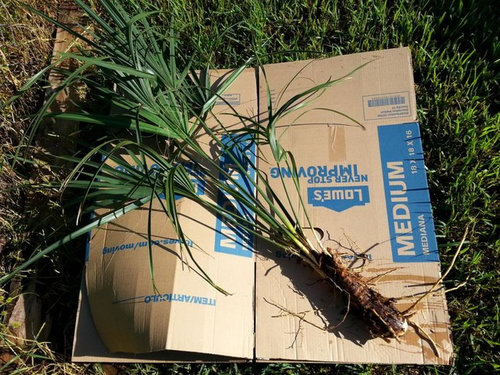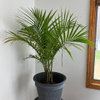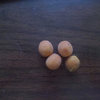I got a call from my In-Laws yesterday saying that they had some palm volunteers under their Water Oak that they wanted gone... or as they called them 'Florida Weeds'. I told them I would come take them off their hands hoping that the volunteers might be Sabal palmettos. Upon seeing the fronds, I knew they weren't Sabal palmettos, or at least felt fairly certain they weren't, and figured they might be Sabal etonia, Sabal minor or Serenoa repens. Upon digging them up and seeing what was below the soil, I kind of ruled out Sabal minor. And once I got them home and compared them to pictures in my book of Florida native plants, I felt more sure that they might be either S. etonia or S. repens. But looking at the fronds and the wispy filaments coming off them, I'm leaning toward the S. etonia as the pictures I have of the S. repens don't show these filaments.
All that said, I'm very much a novice to palms and I know that there are plenty of exotic palms out there that would happily grow in my neck of Florida. And some of them have similar palmate fronds and the wispy filaments (Doesn't the Chinese Fan have similar qualities?). In the interest of planting these in the right spot for them, I want to get confirmation or clarification on their IDs. So below I have a couple of pictures of what was dug up. The first is the largest specimen and had the most damage done to the root system while being dug up. I feel fairly confident with enough nursing it will recover. The second picture is a better look of the fronds, which thankfully are their mature shape and no longer in the grass phase.
Thank you in advance for ya'lls expert, in comparison, help.













jfacendola
Michael AKA Leekle2ManEOriginal Author
Related Professionals
Marco Island Landscape Architects & Landscape Designers · Simi Valley Landscape Architects & Landscape Designers · South Orange Landscape Architects & Landscape Designers · Hartford Landscape Contractors · Middletown Landscape Contractors · Bell Gardens Landscape Contractors · Burlington Landscape Contractors · Fort Myers Landscape Contractors · Gaithersburg Landscape Contractors · Ponte Vedra Beach Landscape Contractors · Tustin Landscape Contractors · Glen Burnie Window Contractors · Northridge Window Contractors · Verona Window Contractors · Watsonville Window Contractorsjfacendola
Michael AKA Leekle2ManEOriginal Author
Michael AKA Leekle2ManEOriginal Author
Michael AKA Leekle2ManEOriginal Author
Michael AKA Leekle2ManEOriginal Author
Michael AKA Leekle2ManEOriginal Author